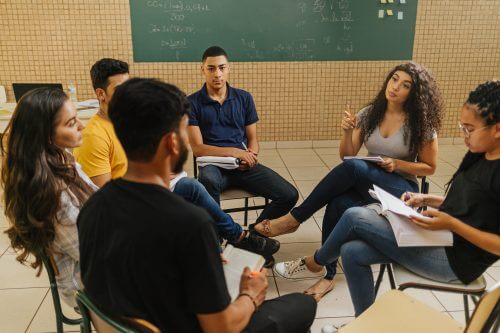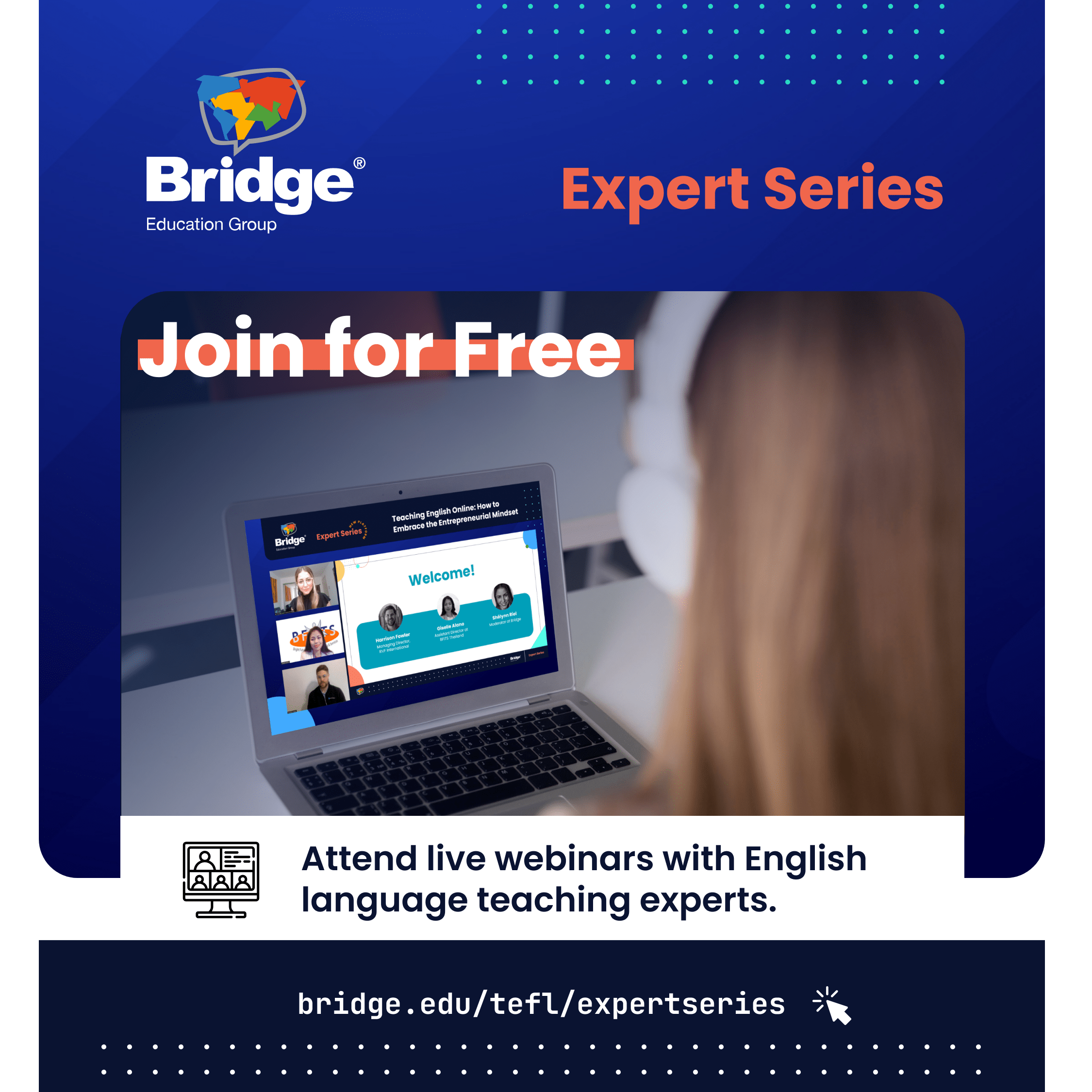ESL teachers must prepare students to apply multiple resources and competencies for 21st-century global, digital exchanges
Denver, CO – If you work in education, you’ve heard the phrase “21st-century learning skills” many times in the last two decades. However, descriptions of these skills have evolved over time, as has the term itself. While educators or others in the industry may continue calling these skill sets 21st-century learning, many have moved on to titles such as global digital citizenship or digital literacy. And in the employment industry, the terminology is often “transferable skills” or “transversal skills.” Educators today are preparing learners for job industries that are complex and constantly evolving. While the initial focus of 21st-century skills may have been on preparing students to navigate complex digital tools, over time the skills have become increasingly focused on soft or human skills.
Human skills are needed to navigate today’s digital landscape effectively, ethically and safely. For teachers of English as a second or foreign language, instruction to teach this navigation occurs simultaneously with language acquisition. To fully grasp 21st-century or transferable skills, it may be helpful to consider the evolution of the concept.
The idea of 21st-century learning is somewhat abstract. The ubiquity of the internet and other advances in technology have changed the way knowledge is both generated and applied. In business, this means there have been shifts in the way producers and consumers are linked, in communication transactions and, to put it simply, in the ways employees do their jobs. These changes also correspond to the classroom – as they should – as what students learn and how they learn it is changing to reflect the needs of today’s job market.
For decades, the widespread belief in education was that if learners can master basic skills – think rote memorization of grammar, mathematics, scientific principles, historical concepts, etc. – they can then learn the deeper skills. While the foundational skills may be important, that narrow view of educational policy made for a boring classroom. It’s no surprise that the format of 20th-century learning resembled an assembly line, as Sir Ken Robinson so aptly described in his discussion on changing educational paradigms. The public school system was modeled in that way and without vast changes in infrastructure, it was unlikely to change.
But today, vast changes have taken place and the job market no longer looks or acts the way it did a century ago. Our world is fast-changing with new technologies that can be tools of learning, as well as tools of networking and knowledge sharing. Students are bombarded with information they must sort through, evaluate and use for decision-making in both their personal and professional lives. The concept of literacy has also always been important, but today that translates well beyond the ability to read, with digital literacy adding layers of critical analysis and evaluation. Students are exposed to oftentimes conflicting information and must assess for biases, validity and more, skill sets that did not exist in this capacity in the last century.
What are transferable skills?
While there may be some debate on the specifics of the transferable (or 21st-century) skills valued by employers of today, as different industries may require strengths in different skill sets, the consensus is that these are soft or human skills, such as interpersonal skills, critical analysis and problem-solving abilities, flexibility, adaptability, global awareness, etc. And of course, these skills are important beyond their professional capacity, providing students with the ability to effectively navigate today’s world in their personal lives as well. But for employers, the need for these skills has become increasingly apparent.

“The globalized scenario demands more than competent professionals who are knowledgeable in their fields and subjects,” said Alicia Salomone, Director of International Relations, University of Chile. “It requires people who can navigate in a changing setting by applying multiple resources and [competencies]. At Universidad de Chile, we define 21st-century learning as a continuous, lifelong process that enhances students’ autonomy, engagement and critical thinking.”
Global ELT publisher Pearson found similar results in a recent study analyzing the most sought-after skills of today’s employers.
Pearson released the first Pearson Skills Outlook report in November, detailing workforce skills trends and identifying key “Power Skills” needed for today’s economy and individuals’ careers. The top five power skills sought after by employers today include:
- Communication: The ability to express thoughts and ideas clearly and to listen to, understand and respond to others’ ideas.
- Customer Service: The provision of service to customers before, during and after a purchase.
- Leadership: The ability of an individual, group or organization to “lead, influence or guide other individuals, teams or entire organizations.”
- Attention to Detail: The ability to be precise and accurate in tasks, taking care to notice small details and ensuring that all aspects of a project are completed accurately.
- Collaboration: The ability to develop constructive and cooperative working relationships with others.
“We looked at the current talent and skills needs of employers, as well as the capabilities that are required to maintain and enhance economic productivity by 2026,” said Gio Giovannelli, Pearson’s President of English Language Learning. “To do this, we analyzed more than 21 million job ads in the US, UK, Canada and Australia, and used Pearson’s workforce AI and predictive analytics to look at census, workforce and recruitment data in those four major economies.”
The report findings did show that technical skills are important in many specific roles but “human skills are now the most in-demand capabilities powering both the world’s economy and individual careers,” Giovannelli said.
Bridge Education Group’s Director of Operations, Anna Hearrell, agreed, saying, “The workforce changes every day, with new technologies and updates to old technologies, so it doesn’t make sense to train extensively for a specific technology. With the rate of change in the world, employers are valuing those hard skills less and less. With the way the world is evolving, the value in a worker is their ability to think critically and on their feet or to assess change.”
Giovannelli also pointed out that “innately interpersonal qualities are highly prized as businesses prioritize transferable traits that are applicable to multiple roles and make employees more rounded and adaptable.”
“More recently, efforts have been underway to integrate into curricula a new generation of skills: the global competencies.”
The Pearson Skills Outlook also noted five “Power Skills” projected to be most in demand by 2026. These include collaboration, customer focus, personal learning and mastery, achievement focus and cultural and social intelligence. View the full report here. The projected skills highlight the continuously evolving shift in the skills needed to navigate a continuously-evolving job market, and yet, many educational institutions are already integrating strategies for teaching students these projected skills as well.
National Geographic Learning provides curriculum and interactive content for English language students and educators and is a leading provider of globally relevant content. The “classic set” of 21st-century skills “most widely referenced during the last 20 years has been the four C’s of Collaboration, Communication, Creativity and Critical Thinking,” said Rachael Gibbon, National Geographic Learning Publisher, Global ELT.
“More recently, efforts have been underway to integrate into curricula a new generation of skills: the global competencies,” she said. These competencies outline the skills, attitudes and behaviors necessary for the achievement of wider-ranging goals like the Sustainable Development Goals.
“They are more rooted in principles of global citizenship and social responsibility,” she said, pointing out that language instruction provides the ideal environment for the development of these skills. “Language is communication, and the English language has become a lingua franca – an essential tool for international communication socially, academically and professionally. How we teach the language should take this role into account, which means also thinking about the types of interpersonal and intercultural skills students will need to interact successfully with people from a range of cultural and linguistic backgrounds.”

Supporting this focus on interpersonal and intercultural skills, Salomone, of the University of Chile, included “effective communication, knowledge of foreign languages, intercultural and environmental awareness, leadership, teamwork, empathy, innovation and critical and creative thinking” as important competencies for students to master in preparation for the job market.
To learn more about transferable skills and get tips for incorporating them into your lessons, download Bridge’s free guide: Teaching 21st-Century Skills in the ESL/EFL Classroom.
How is curricula changing to meet 21st-century learning needs?
English language students may range in age from young children taking English language courses to adults taking business or occupational English courses to further professional opportunities. Bridge Education Group offers Micro-credential courses covering the following 21st-century skills topics: introduction to promoting 21st-century skills in the classroom; digital literacy; critical thinking; creative and innovative thinking; leadership and confidence; developing students’ education and career pathways; cultural, global and environmental awareness; and communication, collaboration and interpersonal skills. While ESL teachers may be focusing on language acquisition, the application of language requires additional skill sets that meet many of the needs of transferable skills employers seek today. Courses such as these prepare ESL teachers to create lessons and activities that will combine core instruction with these valuable skills. Both instructional methodologies and curricula have vastly changed to meet the needs of today’s students.
“The point is that the language comes first, but these activities that support skills acquisition are part of the instruction.”
“As little as 20 years ago, academic research and schools were focusing on how to read an encyclopedia or navigate a library and treating it as a one-stop place for trusted information,” said Anna Hearrell, Bridge Director of Operations. “With the rise of the internet, almost overnight that type of curriculum became obsolete, and now teachers need to focus on critical thinking and investigating sources, determining what is a trusted source, etc.”
English language instruction provides a unique opportunity to combine these investigative and evaluative skills with language learning. While there are some very positive aspects to this focus on instruction, there are some challenges, as well. “Learners may not be able to articulate their thoughts clearly,” Hearrell said. “This may cause anxiety if expectations are too high.”
However, ESL teachers also have many opportunities to combine language instruction with activities that build these types of transferable skills. Hearrell provided the example of reviewing social media posts in English, and then investigating the sources for the legitimacy of their claims. “You’re using language first, and then practicing the transferable skill,” she said.
The Bridge Micro-credential courses provide both the reasoning behind the importance of teaching these skills and easily applied examples of activities that can be used in the classroom for a variety of age groups.
Research on sustainable learning shows that interdisciplinary, practical and embedded tasks are usually more effective than isolated approaches. The most effective instructional strategy for understanding and retention of information is teaching students these skills in ways that are combined with core instruction, rather than separately. For example, teaching ESL students the transferable skills of leadership, collaboration and teamwork may look like a group language project or activity that provides students autonomy to problem-solve, identify leadership qualities of group members and work together toward a common goal. Completing the language project or activity is the goal, but identifying and developing the transferable skills in the process is a secondary, underlying goal. Transparent discussion of the qualities of good leadership and leadership theory, such as those discussed in the Bridge Micro-credential course: Instilling Confidence and Leadership Skills in Your Learners, helps students identify those qualities in themselves, increasing engagement and efficacy.
“With the rise of the internet, almost overnight that type of curriculum became obsolete, and now teachers need to focus on critical thinking and investigating sources, determining what is a trusted source, etc.”
“I think ESL teachers are doing these kinds of things more than they know,” Hearrell said. “It has to come organically. The point is that the language comes first, but these activities that support skills acquisition are part of the instruction.”
Gibbon, from National Geographic Learning, also suggested taking the role of the English language as an essential tool for international communication into account when considering how it is taught. This means “thinking about the types of interpersonal and intercultural skills that students will need to interact successfully with people from a range of cultural and linguistic backgrounds, to be more empathetic, inclusive and flexible as communicators.”
In the recent National Geographic Learning publication and skills program, Voices, the creators visualized “a learner going out into the world, needing to operate across cultural and national boundaries.” Questions considered for this learner included: What types of skills and competencies does someone need to have to do this confidently and effectively? How can we help the learner develop their own voice?
“That was our starting point, and every aspect of the materials work towards preparing learners for that reality,” Gibbon said. Using Voices, learners apply English as a tool for global communication. The Voices publication is a seven-level, integrated skills program for adults and young learners, and includes a professional development video program for teachers.
As Hearrell noted, and as it may be inferred by the Voices skills program, the teaching of 21st-century skills, or integrated skills, may be woven into language instruction through a variety of activities that support both language acquisition skills and the human or soft skills needed for today’s technologically driven environment.
One difficulty expressed by many educators is the assessment of many of these soft skills. How does one assess leadership, for example? As instructional methods shift to more collaborative-based models with teachers acting as guides or facilitators, a similar shift in assessment models may follow as well. The DigComp Framework for Citizens, published on the European Union’s Science Hub, not only outlines five key components of digital competence but provides competence assessment tools that may be personalized according to the individual student or classroom. The Optimizing Assessment All (OAA) initiative, which is studying participants from 17 countries and jurisdictions, is also working collaboratively to provide pedagogical and assessment approaches for 21st-century learners.
There is no simple answer for the perfect assessment tool for every skill, but the tools and resources are out there for teachers to build upon for their specific needs, and in the spirit of developing these 21st-century skills, a collaborative approach with students to identify objectives and goals that may be used for self or peer assessment may be just as effective – not to mention engaging and empowering – for today’s students.
What does the future hold?
When looking back on the first two decades of the 21st century, it’s clear the skills necessary to navigate the changing landscapes of communication patterns and platforms, analysis of information and its sources and responsible interactions in today’s globalized industry will continue to evolve.
Andreas Schleicher, Organisation for Economic Co-operation and Development (OECD) Education Directorate, described a trend in the knowledge world that moves beyond typical specialists and generalists to “’versatilists,’ who apply depth of skill to a progressively widening scope of situations and experiences, gaining new competencies, building relationships and assuming new roles.”

After decades or even centuries of knowledge becoming increasingly specialized, with education focused on providing depth of knowledge in specialty areas, technological advances that spurred changes in interaction and communication patterns are shifting the focus of knowledge to a broader scope. Digital and media literacy encompass skills from a broad spectrum of competencies, and today’s job market requires all of those skills in addition to regularly updated technological competence.
The technologies will continue to evolve, and with those changes, the need for human skills and those technology literacies will grow. Understanding not just the denotative functions of technologies but the connotative – how particular forms of technology function and to what end – will be needed to identify efficiencies, limitations and potential ethical and moral implications.
Salomone is part of the University of Chile’s Internationalization Project, which aims to provide students with opportunities to internationalize their careers and boost the international engagement of the university. The project’s focus is to improve English proficiency levels of students and lecturers, making it possible to introduce courses taught in English and to participate in international programs such as the Association of Pacific Rim Universities (APRU) Virtual Student Exchange.
“We have also started to deliver courses to boost students’ intercultural competence,” Salomone said.
Salomone also partners with another professor, Ludmila Kalasnikova, offering the online course, English as a Medium of Instruction: Planning and Teaching your Subject in English. The course raises “lecturers’ awareness to move forward from traditional, teacher-centered learning toward student-centered teaching, which entails boosting students’ autonomy and engagement, enhancing critical thinking and creativity and raising intercultural and environmental awareness.”
Salomone also partners with Cecilia Saint-Pierre, who heads the university’s Online Education Office, which set the foundation for the development of Technology-Mediated Education, or TME. Despite the name, “this model is far from being a ‘technologically proficient’ approach. By contrast, it points to incorporating technologies that are suitable for student-centered teaching and for promoting classroom interaction. In this way, it aims to develop [competencies] that are paramount for 21st-century learning, such as digital literacy, interpersonal skills, student engagement, critical thinking, intercultural competence, sustainability awareness and global citizenship.”
“We have also started to deliver courses to boost students’ intercultural competence.”
Like these examples of educational strides in equipping educators and students to meet the needs of the 21st century, other universities, nonprofit organizations and governments are providing frameworks and other supports for the teaching of these transferable skill sets that will equip students to navigate both their professional and personal lives. There are internationally-recognized qualifications such as the IB Diploma founded on principles of global citizenship and tertiary institutions, such as Manchester University in the UK, with the core goals of social responsibility. The Aga Khan Foundation in Canada provides an educator’s guide to global citizenship with tools to equip educators to teach sustainable development and global citizenship, and the UK-based Students Organising for Sustainability’s campaign, SDG Teach In, provides resources for formal, informal and subliminal curriculum supporting the 17 goals of instruction developed by the United Nations Department of Economic and Social Affairs Sustainable Development. Goals include no poverty; zero hunger; good health and well-being; quality education; gender equality; clean water and sanitation; affordable and clean energy; decent work and economic growth; industry, innovation and infrastructure; reduced inequalities; sustainable cities and communities; responsible consumption and production; climate action; life below water; life on land; peace, justice and strong institutions; and partnerships for the goals.

Nonprofits such as Common Sense provide resources to students, educators and parents to support digital literacy and citizenship. The foundation Edutopia also provides resources to help educators introduce digital literacy and citizenship, as does Google with the Be Internet Awesome campaign and Teach InCtrl with its Teaching Digital Citizenship campaign. And, as stated earlier, the EU Science Hub has the DigComp Framework for Citizens providing a common understanding of digital competence. The framework identifies the five key components of digital competence as problem-solving, information and data literacy, communication and collaboration, digital content and creation and safety, and within those areas, 21 competencies are identified. The framework continues to be updated, with DigComp 2.2 being the most recent iteration. The project, implemented by the Joint Research Centre on behalf of the European Commission, provides tools in support of the EU’s Digital Education Action Plan 2021-2027, with the goal of framing digital skills policy. DigComp may be used to design competence assessment tools, create training courses and materials and identify professional digital profiles for employment, education, training and social inclusion.
“Employers will value these transferable skills because these workers will thrive no matter the environment.”
Also mentioned above, the Optimizing Assessment All (OAA) is an initiative of the nonprofit public policy Brookings Institute. The initiative’s goal is to strengthen education systems’ capacity to integrate 21st-century skills in teaching and learning. Started in 2017, OAA is focused on countries in Asia and Africa. Study participants from eight countries and jurisdictions in the Asia-Pacific and nine in sub-Saharan Africa provided perspective on how to approach teaching and assessing of 21st-century learning skills in the classroom and prompted the foundation for a second study, which was the Asia-Pacific region report. The focus of the initiative is collaboratively working with many countries to build capacity in pedagogical and assessment approaches that target 21st-century learning skills. Key partners in the project include Nepal, Cambodia, Mongolia, the Democratic Republic of Congo, The Gambia and Zambia.
Tomorrow’s students will likely need to be multi-functional, building depths of knowledge in a broad variety of skill sets that encompass not only the functional skills of the professional role they attain but also the emotional and intellectual skills needed to problem-solve, make connections and consider the global picture. Preparing students for today’s world and for the future requires a global effort and the support of the many schools, universities, nonprofit organizations, governments and research institutions working to continually identify and equip students with the skills necessary to successfully navigate our evolving world.
“With the way the world is evolving, the value of a worker to think critically and on their feet or to assess change matters much more than their ability to know one thing,” Hearrell said. “It’s almost guaranteed that it’ll look different in a five-year plan. Employers will value these transferable skills because these workers will thrive no matter the environment.”
Pearson’s Giovannelli agreed, saying that while technical skills are important for many jobs and will continue to be in the future, “employers are now realizing that human skills are the ones with longevity. Those very human capabilities like communication, collaboration and attention to detail are the foundation for being adaptable and having the ability to learn other, more technical skills. A strong foundation of human skills is essential for success for employers and employees now and in the future.”











